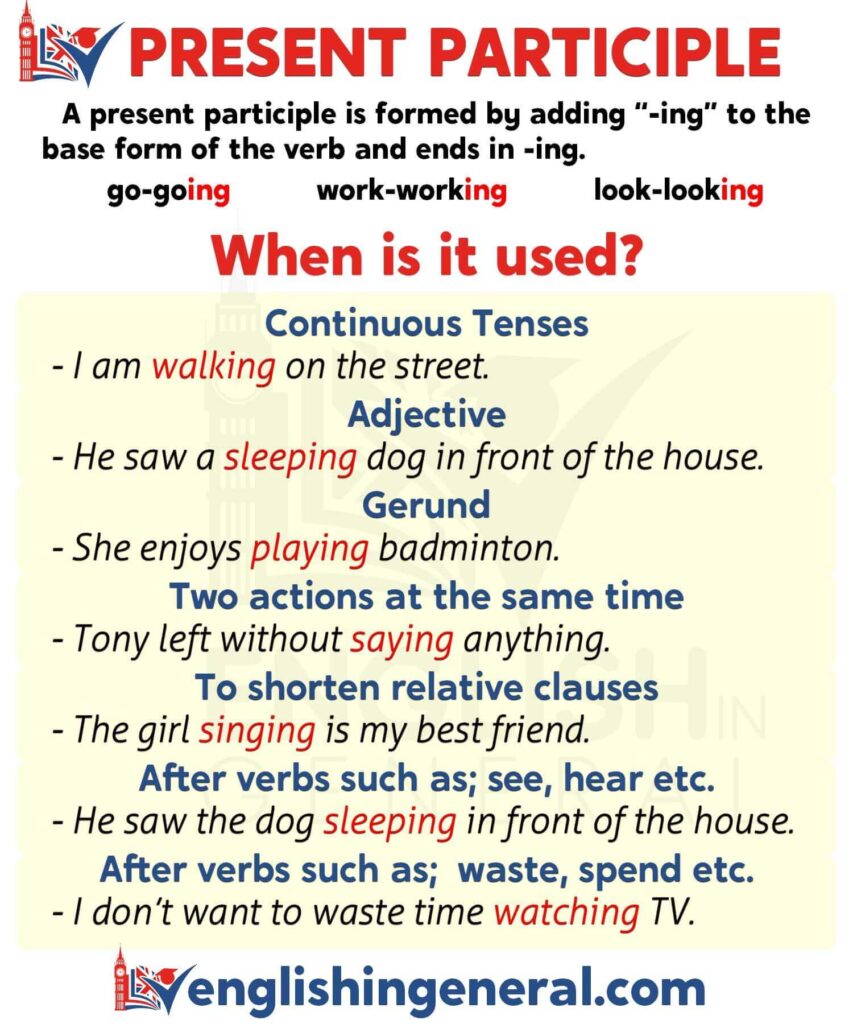
The present participle or ing-participle, or simply ing-form can be used in various ways in English. It is not limited to a fixed part of speech! In general, it is often used as follows:
The present participle can take on the role of different parts of speech.
As a main verb in the ing-form (progressive form) in the continuous tenses.
Present Continuous:
“She is singing a song.” (She’s singing a song right now.)
Present Perfect Continuous:
“I have been waiting for two hours.” (I’ve been waiting for two hours.)
Past Continuous:
“Max was repairing his car.”
Past Perfect Continuous:
“We had been walking for 30 minutes before a friend picked us up.” (We had walked 30 minutes before a friend picked us up.)
Future Continuous:
“Next week I will be flying to Italy.” (I’ll be flying to Italy next week.)
Future Perfect Continuous:
“They will have been travelling around the world by the end of the year.” (They will have travelled the world by the end of the year.)
Use of the present participle as an adjective, with reference to a noun:
“My trip to South America was an exciting experience.”
“The movie was very interesting.” (The film was very interesting.)
Or direct use as a noun in the form of the gerund (gerund):
“My brother is taking driving lessons.” (My brother is currently taking driving lessons.)
“Running a marathon is very difficult.”
The ing participle can be used to connect sentences or sub-clauses with the same subject:
“Tony left without saying anything.”
“Tony left and didn’t say anything.” (Two sub-clauses are connected by the conjunction ‘and’.)
“He left. He didn’t say anything. ” (two sentences)
Or also to shorten relative clauses, whereby the relative pronoun is omitted:
“The man living next door is my grandfather.” (The man who lives next door is my grandfather.)
“The man who lives next door is my grandfather.” (here with relative pronouns)
Use of the ing-form after verbs that express rest and movement, e.g. B. ‘go, come, run, lie, sit, stand, stay’:
“The woman ran screaming down the street.” (The woman ran down the street screaming.)
Or even after verbs that describe sensory perception, such as B. feel, hear, see, watch, smell, listen to, notice, find ’:
“The postman saw the dog sleeping in front of the house.”
The present participle can also be used in sentences with ‘there + to be’ (is, are, have been, etc.):
“In the city center, there was a car driving too fast.” (A car was going too fast in the center of town.)
“There are a lot of people waiting in line at the bank.” (Lots of people are waiting in line at the bank.)
In addition, there is a whole range of verbs for which the following verb can or must be in the ing-form. There may be a difference in meaning between the ing and the simple form:
Example verbs, which can be followed by the present participle, can be ‘start, continue, begin’ etc.:
“The teacher continued showing the video.” (The teacher continued the video demonstration.)
Examples of verbs that the ing form must follow include u. a. ‘Finish, avoid, keep on, suggest, enjoy, mind’:
“Sue has just finished painting.” (Sue just finished painting.)
Verbs that have a meaning different from the following simple form with an ing-form are, for example, ‘stop, regret, remember’:
“Finally, it stopped raining.” (Eventually, it stopped raining.)
How is the present participle formed (special features of the spelling)?
The present participle is generally formed by adding the ending ‘-ing’ to the root of the word (also called the ing participle). However, some special features must be taken into account in education. Compare the following form in detail:
In most cases an ‘-ing’ is simply added to the verb without changing it:
talk → talking
spy → spying
However, if the verb ends in ‘-e’, this is omitted:
take → taking
move → moving
Be careful: if you double the ‘e’ at the end of the verb, this is retained:
see → seeing
If the verb ends in a stressed vowel + consonant, the consonant is doubled:
run → running
fit → fitting
prefer → preferring
Pay attention: Verbs whose last syllable is not stressed do not get a doubling of the consonant (for exceptions see differences in American and British English below):
render → rendering
reckon → reckoning
Likewise, the consonant is not doubled with a double vowel:
conceal → concealing
For verbs that end in ‘-ie’, the -ie ’is replaced by a‘ -y ’in order to avoid three vowels in a row:
tie → tying
lie → lying
Verbs that have an ‘-ic’ at the end are given an additional ‘-k’ before the ending ‘-ing’:
panic → panicking
Differences in the present participle in American and British English
There are slight differences in the formation of the present participle (ing form) and the spelling between British and American English. The following must be observed in detail:
In British English, verbs that end with a stressed or an unstressed vowel + ‘-l’ have the ‘-l’ doubled, and ‘-ing’ is added:
travel → travelling (the unstressed vowel in the last syllable; ‘-l’ is doubled)
enrol → enrolling (stressed vowel at the end; ‘-l’ is also doubled here)
In American, however, the ‘-l’ is only doubled in verbs that end in a stressed vowel + ‘-l’:
travel → traveling (the unstressed vowel in the last syllable, accordingly no doubling)
enroll → enrolling (stressed vowel at the end, thereby doubling)







Very useful